Excerpts from Jim Conrad's
Naturalist Newsletter
entry from field notes dated July 3, 2022, taken on the eastern lower slope of Cerro de la Cruz, at an elevation of ~2700m (~8850 ft), just south of the community of El Pinar, Amealco de Bonfil, Querétaro, MÉXICO, (~N20.17°, ~W100.17°)
FRAGILE FERN
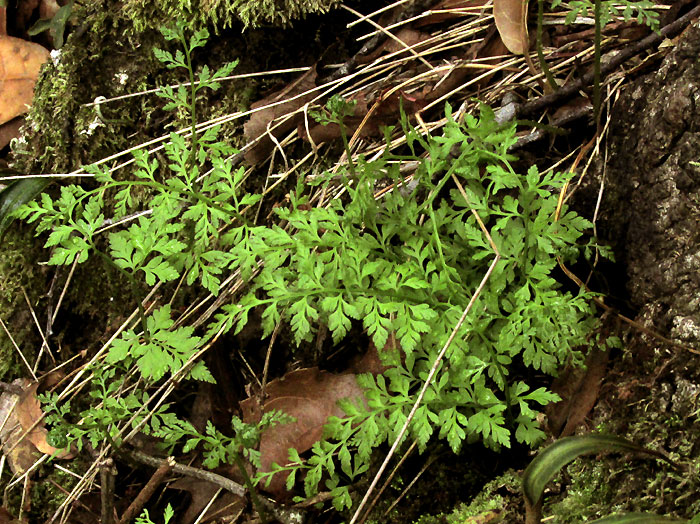
On the lower eastern slope of Cerro de la Cruz where the valley floor begins and the oak forest transitions to open grassy, scrubby vegetation and bare rock, the above fern, after a hard, extended dry season, was emerging from a crack between two outcropping rocks. The rocks were andesitic ignimbrite, ignimbrite being hardened volcanic rock composed of crystal and rock fragments in a tuff-based, glass-shard groundmass. The adjective andesitic indicates that the rock was about 52 to 63% by weight silica content (SiO2).
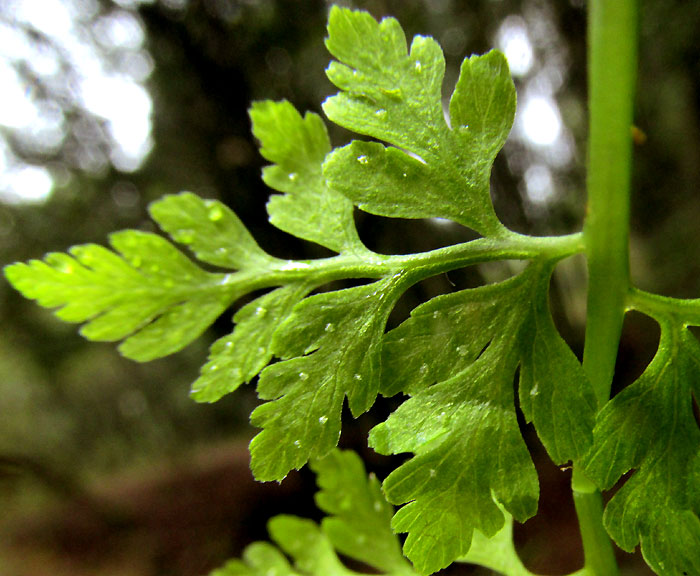
As seen above, sori were just beginning to form -- the tiny, whitish spots scattered here and there across the blade. Still, it seemed apparent that the sori were roundish, not elongated, and they arose on the blade's surface, not at the margin. They appeared singly, not arranged in lines or clusters. And they were positioned atop or right beside forking veins that continued all the way to blade margins, all better seen in the blurry close-up below:
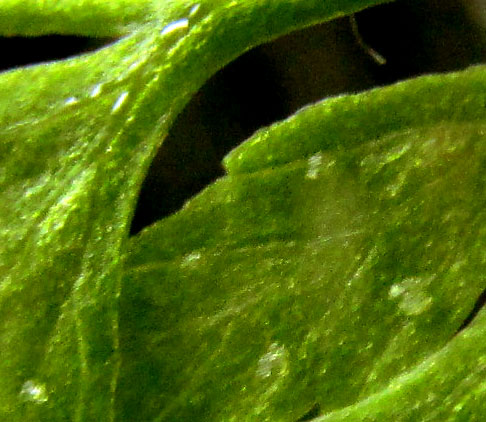
The fern strongly suggested plants seen among moist, shady rock outcrops in the hills back in my childhood Kentucky, both the Cliff Fern Woodsia obtusa and the Fragile Fern, Cystopteris fragils. These two species can be hard to distinguish if you don't have the spore-producing sori handy and in the right stage.
In the above picture, you can see the first stage of a frond's developing sori. On the basis of the pinnules' shapes, we'll call these Fragile Ferns, CYSTOPTERIS FRAGILS, and hope to get better formed sori later. This species occurs throughout most of the world, except Australia, most of Africa and south-east Asia, and eastern South America.
entry from field notes dated January 19, 2023, taken along steep, one-lane gravel road ascending forested, northeast-facing mountain slope, elevation ±2,380m (7600 ft); bedrock of Cretaceous limestone; on the south side of Pinal de Amoles, Querétaro state, MÉXICO, (N21.134°, W99.629°)
FRAGILE FERN WITH MATURE SORI
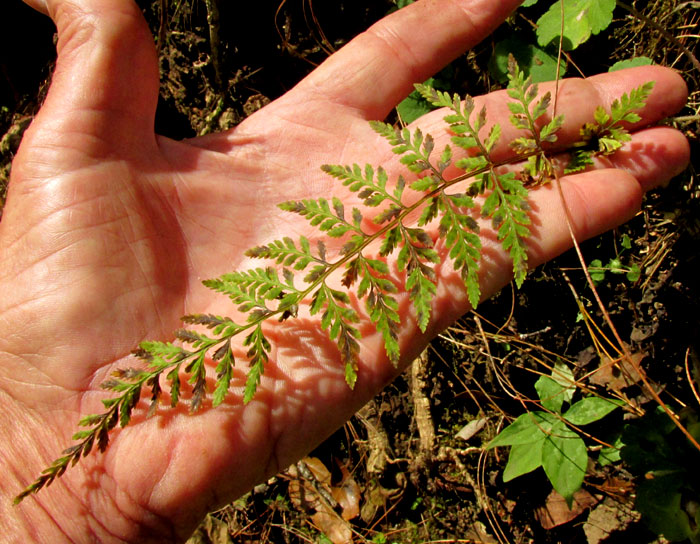
The above grew on a steep embankment beneath pine trees, where direct sunlight only seldom entered. It was the Fragile Fern, Cystopteris fragilis, but unlike the one featured earlier, now in January the frond was an old one, with plenty of mature sori.
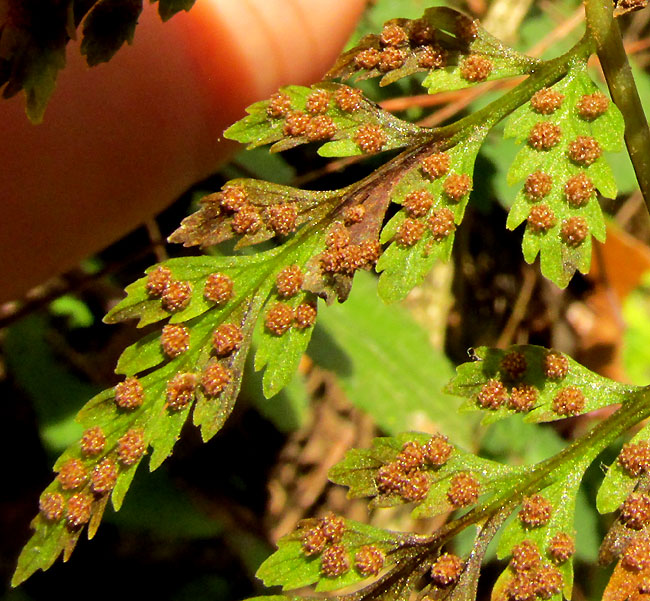
Sori on this individual appear to be too mature to show its papery indusia, which the Flora of North America describes for the genus as "... hoodlike and arching over sorus toward margin, attached to receptacle base on costal side, persistent to ephemeral or often obscure at maturity." This frond's indusia certainly are obscure at maturity. A closer look shows that they're more than obscure:
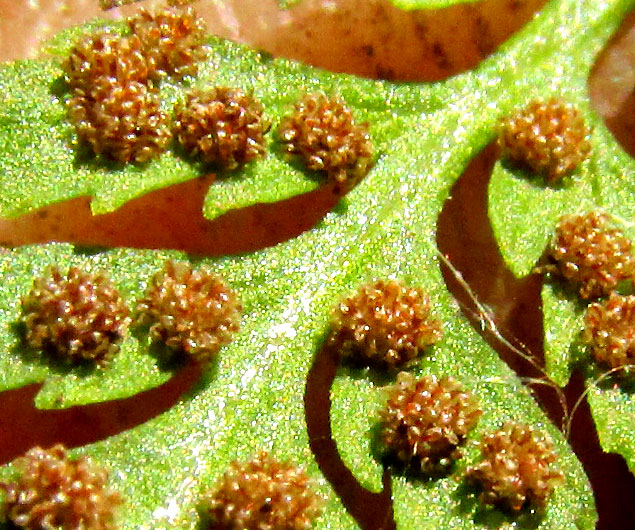
The Flora of North America also says that Cystopteris fragilis "... probably contains a number of natural, cryptic evolutionary units," thus hinting that eventually the taxon may be split into various species or varieties. It further says that western North America Fragile Ferns appear to be developing morphological and ecological variants. The same may be true of our ferns, for the Western Sierra Madre mountains are a more southern expression of western North America's Rocky Mountain chain.
Beyond its taxonomic ambiguity, in the 2001 work by Eleazar Carranza González entitled "Notes Sobre Plantas Medicinales del Estado de Querétaro, México, dealing with medicinal plants here in the state of Querétaro, I read that to treat bronchial pneumonia the whole fern should be boiled in a quarter liter of water, along with two garlic cloves, and the resulting tea should be drunk three times a day. At the pfaf.org website, it says that infusions of the fern's roots have been used as enemas to rid the intestines of parasitic worms.
Entry from field notes dated September 3, 2023, taken in Los Mármoles National Park in the Eastern Sierra Madre mountains, Hidalgo state, MÉXICO; oak-pine forested mountain peak about 3km west of Puerto de Piedra, on road branched off the road between Trancas {on maps designated "Morelos (Trancas)"} and Nicolás Flores; limestone bedrock; elevation ~2,650m (~8,700ft); N20.816°, W99.214°
SORI WITH INDUSIA
The previous entries featured ferns to old or young to display sori with their indusia intact. This time we have some individuals with sori. First, here's what the population looked like:

Here's what the sori looked like:

The indusia are like shallow, green cups attached to the leaf on the rachis side, partly coveringthe green, immature sporangia.